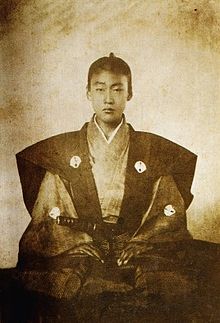Nabeshima (clan)
The Nabeshima ( Japanese 鍋 島 氏 , Nabeshima-shi ) formed a family of the Japanese sword nobility ( Buke ), which were derived from Shōni ( 小 貳 ) Tsunefusa and thus from the Fujiwara . With an income of 357,000 Koku , the Nabeshima residing in Saga ( Hizen ) belonged to the great Tozama daimyo of the Edo period .
history
The Nabeshima were a sideline of the Shōni clan and thus descended from the powerful and respected Fujiwara family . After the Shōni clan was in decline after several defeats against the Ōuchi and the Ryūzōji , Shōni Shigenao founded his own clan in Nabeshima in the province of Hizen and took the name of the city. In the struggle for supremacy on Kyūshū , the Nabeshima supported the Ryūzōji clan, but were decisively defeated in 1584 by the rising Shimazu clan .
In 1587, the clan was a supporter of Toyotomi Hideyoshi during his invasion of Kyushu. In gratitude, she enfeoffed Hideyoshi with the region around Saga , which later became the Saga fief . The head of the family, Nabeshima Naoshige , was also one of the commanders in the Imjin War , Hideyoshi's long-planned invasion of Korea.
After Hideyoshi's death in 1598, there was considerable tension between the Council of Five Regents appointed by him and the extremely ambitious daimyo of Mikawa , Tokugawa Ieyasu , who was also a member of the council. The Nabeshima initially supported Ishida Mitsunari , but changed sides before the Battle of Sekigahara and involved Tachibana Muneshige in a bitter guerrilla war to keep him from participating in the battle. After Tokugawa Ieyasu's final victory, Nabeshima Naoshige was considered a Tozama daimyo , which excluded the family from government posts, but they were allowed to keep the fiefdom of Saga, one of the richest regions in Japan.
As supporters of the Tokugawa Shogunate, they were instrumental in suppressing the Christian Shimabara uprising in 1637.
In the Boshin War , the Nabeshima joined the reform forces of the Satsuma - Chōshū Alliance. The abolition of the Han in 1871 ended the family's rule over Saga, but the Nabeshima were also among the influential families of Japan, the so-called Meiji oligarchy , during the Meiji period .
Overview of the family
-
Shigenao ( 茂 尚 ), son of Tsunefusa, settled in Nabeshima (Hizen) towards the end of the 15th century and took the name of the place.
-
Naoshige ( 直 茂 ; 1537–1619)
- Katsushige ( 勝 茂 ; 1580–1657)
- |
-
Naomasa ( 直 正 ; 1815–1871)
- Naohiro ( 直 大 ; 1846–1921), the last daimyo, went to England to study with two brothers in 1871
- Main line in Saga, 357,000 Koku, after the Meiji Restoration "Prince" until 1945
- Other members of the family:
- Tadanao, studied from 1911 to 1914 at the Tharandt Forest Academy
- Naotsugu ( 直 紹 ; 1912–1981), son of Tadanao, was a politician and researcher of Japanese porcelain.
- Branch line in Ogi ( 小城 ), 73,000 Koku, Vizegraf
- Branch line in Hasuike ( 蓮池 ), 53,000 Koku, Vizegraf
- Tadashige ( 忠 茂 ; 1537–1619)
- Branch line in Kashima ( 鹿島 ), 20,000 Koku, Vice Count
-
Naoshige ( 直 茂 ; 1537–1619)
The branch lines, all located in Hizen, contented themselves with a "permanent house" ( 陣 屋 , jinya).
Other members of the clan
Others
During the Edo period, numerous porcelain manufacturers were established in the fiefdom. The famous Imari porcelain , named after the port city of Imari , enjoyed great popularity in Japan and was also exported to Europe in considerable numbers. The Nabeshima porcelain is named after the family , the decoration of which has broken away from the Chinese models and appears "modern".
Individual evidence
- ↑ a b T. Furusawa: Kamon daicho . Kin'ensha, n.d., ISBN 4-321-31720-7 , p. 226.
Remarks
- ↑ suction. "Kamishimo" ( 裃 ) garb.
literature
- A History of Japan, 1334-1615 , George Bailey Sansom, 1961, Stanford University Press, ISBN 0-8047-0525-9 .
- Edmond Papinot: Historical and Geographical Dictionary of Japan. Reprint of the original 1910 edition by Tuttle, 1972. ISBN 0-8048-0996-8 .
Web links
- For more information (english)



